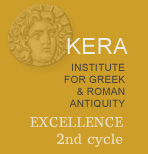Main Site . Sebasteion
14. Dedication of a statue of Septimius Severus
![]()
İnan, however, misreads Jones (p. 292), who points to the horizontal stroke after the final nu of Ἀντωνεῖνον, and speculates that the inscription may not be complete. If, on the other hand, the inscription is complete, Ἀντωνεῖνον could refer to a number of emperors according to Jones. Jones does not, as İnan's implies, speculate on that horizontal line possibly belonging to an Omega, and Ἀντωνεῖνον therefore being in fact the genitiv plural Ἀντωνείνων (İnan p. 224). Concerning the statue of Commodus, İnan p. 224 writes that it was the largest of all (a torso of 1,40 m without the head), but the torso most likely to have represented Septimius Severus was much larger: a torso of 2,165 m and a head of 0,49 m. See İnan p. 226 ("wahrlich kolossal").
| Αὐτοκράτορα Καίσαρα Λ(ούκιον) Σεπτίμιον Σεουῆρον Εὐσεβῆ Περτίνακα Σεβαστόν |
Imperator Caesar Lucius Septimius Severus Pius Pertinax Augustus
Inscription on the pedestal at the north wall of the Sebasteion. The inscription occupies block E 14.
Letters: 2.5 cm.
Jones 1979, no. 12 (pl. 78.1); SEG 27 (1977), no. 919; İnan 1993, pp. 225-227, no. 6 (pl. XIII, E cf. pl. XV and XVII.15).
L. 1 : The abbreviation Λ(ούκιον) is indicated by points both before and after the letter Λ.
L. 2 : Jones, op. cit., 293 notes that "the name 'Pertinax' would suggest an early date, if the Historia Augusta (Sept. Sev. 7.9) were right in saying that Severus after a while abandoned the use of this name quasi omen: but that statement is not borne out by the inscriptions of Severus". The dedication of this statue must belong to the period between 198 (when his son Caracalla was named Augustus, see below, no. 16) and 211 CE, the year of Severus' death.
Though it had been assigned originally to the east pediment by the first excavator, M. Yılmaz, it was established later, during the excavation of 1990, that block E 14 belongs to the top course of stones of the north pediment (İnan, op. cit., 225). The upper surface of that course of stones is now mostly covered with soil that has come down from the slope. E 14, being in the NE corner of the excavated room, and thus being exposed on two sides, was almost completely covered with earth during our first visits to the site, but in 2007 the site guard had cleared the surface to the extent it was possible without destabilizing the hillside. On its upper surface, where İnan recognizes two footholes that would accomodate the right feet of statues, there are at least three flat hollows of rather indefinite shape. One of those hollows, according to İnan, could correspond to a very large bronze found in Boubon which represents, again in the same author’s view, Septimius Severus as Alexander with a lance (İnan, op. cit., pl. XXX.34; XXXI.35-38; XXXII; Queyrel 2003, p. 119, nos. 9 and 10). The statue was unearthed intact by illegal excavators, but was apparently mutilated in a (failed) attempt to sell the head and body separately to the same buyer. The result was that the torso and head are now in different collections and countries: whereas the body belongs to the Dorothy Wendall Cherry Collection in New York, the head is at the Ny Carlsberg Glyptotek in Copenhagen. Standing ca. 2,65 m in height (İnan, op. cit., p. 226), this is the largest of the bronzes known to have belonged to the Sebasteion. The statue was some 40 cm higher than that of Severus' predecessor. In my opinion, this fact offers support to İnan's identification of the two statues as Commodus and Septimius Severus. Having dedicated an over-life- size sculpture of an emperor (in this case Commodus), it was inevitable that a statue of his successor in the same architectural context, especially if it was designed to stand close to that of the dead emperor, must be of similar or greater size. Anything less could be seen as a slight to the reigning emperor. According to İnan's reconstruction, the statues of Septimius Severus and his family were originally erected on the east pedestal, which must have been entirely occupied by that statue group. The sons Caracalla and Geta stood between their parents, Julia Domna on their left (from the viewer's perspective) and Septimius Severus on the right, at the right end of the east pedestal. Septimius Severus was re-located to the north pedestal in the third century, to make room on the east pedestal for the statues of another imperial family (nos. 19, 20, 21. Burrell 2004, p. 108, sees this re-location as importing Septimius Severus into an Antonine family group). Consequently, the surviving dedication of the statue of Septimius Severus is an inscription from the middle of the third century or later, similar in lettering and style to those for Gallienus, Salonina and Valerianus I. However, the original dedication must have taken place at the same time as those of his family, between 198 and 211 CE. It must have been carved on block F 7, though no clear signs of erasure are detectible on the surface of that stone today.
It seems noteworthy that the dedication in honor of Septimius Severus, when it was re-carved in the third century, was crammed in the narrow space available on stone E 14. One would expect the new inscription for Commodus to have been carved on E 6-7 instead, corresponding to the new position of that emperor's statue; the inscription for the re-located Septimius Severus could then occupy the surface made available on E 7-8. But apparently the same approach was chosen both for re-carving an old inscription and inscribing the new third-century dedications, which were confined to the top course of stones on the east pedestal instead of extending into the ample space available on F 7.

